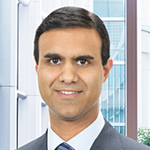Combating muted equity risk premium

|
Written By: Monica Fan |

|
Raman Srivastava |

|
Paul Hatfield |
Monica Fan from BNY Mellon interviews Raman Srivastava, Deputy CIO of Standish1 and Paul Hatfield, CIO of Alcentra, on their outlook for the fixed income market and the opportunities to generate positive returns
Volatile market conditions, bearish equity, sharp downgrades to the forecast equity risk premium and expectations that interest rates in the Eurozone and the UK will stay “lower for longer” have fuelled investors’ interest in adding diversified multi-sector global fixed income strategies to their growth portfolios. Multi-asset strategies are popular for two main reasons. First, they allow managers to opportunistically and dynamically allocate capital between developed and emerging market sovereign bonds, investment and sub-investment grade credit, asset-backed securities, secured and unsecured loans, and direct lending, when attractive opportunities arise. Second, many multi-sector fixed income strategies have a strong focus on capital preservation and techniques used to generate positive convexity in the portfolio.
Many investors forecast a negligible equity risk premium over the next decade and are considering replacing equities with diversified fixed income strategies in their growth portfolio.
Monica Fan (MF): What are your thoughts on the relative returns of diversified fixed income vs equity returns over the next three years?
Raman Srivastava (RS): I expect bond yields will continue to rise only very gradually over the next several years due to lower rates of global growth and inflation so it makes sense for institutions with a long-term investment horizon to diversify into fixed income. Continued monetary easing will make fixed income more attractive than equity on a risk-adjusted basis.
Paul Hatfield (PH): I think a diversified fixed income portfolio should show better returns than equity in the next three years with lower volatility. As governments struggle to generate growth and inflation remains stubbornly low, returns from interest income look more attractive and should be more stable.
MF: What is your outlook for short-term and long-term interest rates and volatility over the next three years? What types of returns do you expect to see and how do you plan to generate them over the next three years?
PH: I don’t see interest rates rising in Europe at all in the next two to three years as the ECB continues its programme of monetary stimulus. We have seen rates rise in the US and there is a risk they could be cut if growth doesn’t return but I think that is unlikely. Competitive devaluations around the globe make it likely rates will stay low for the foreseeable future. We have seen yield curves flattening and if we get more recessionary indications of a trend, then you would expect to see the curve continue that trend.
RS: Persistent low growth, low inflation and low interest rates are likely to be the hallmarks of the global economy over the next several years. In this type of global macro environment we expect to generate 3-5% per annum. Strong demand for long-dated bonds from pension funds will keep a lid on the extent to which long term interest rates can rise in the US and the UK. At the short end of the curve, the European Central Bank is unlikely to move to a tightening bias. On the contrary, the ECB could move back to easing rates further before it eventually reverses quantitative easing. The interest rate market has already discounted that the Bank of England will follow the Federal Reserve’s tightening of monetary policy so investors have little to fear from a rapid tightening of monetary policy.
MF: What do you think are the greatest opportunities in the fixed income market by sector and country?
RS: Volatile market conditions over the next several years will reward nimble asset allocators. There is value in US and European high yield debt; US commercial securities and asset-backed securities; developed market sovereigns which have not fully discounted the risk of policy easing and select emerging market debt.
PH: Bank deleveraging in Europe is creating exciting opportunities on two fronts. There is a gap in SME funding as banks withdraw from that market for risk capital and regulatory reasons. Providing loans to this market on a direct bilateral basis can yield attractive returns for senior secured lending. At the other end of the spectrum, banks in Europe need to clean up their balance sheets and will at last be forced to sell off their non-performing loans which will provide opportunities for distressed debt funds.
MF: Investors increasingly want downside protection in their portfolio. How do you prevent catastrophic capital losses in your portfolio?
RS: Depending upon market conditions, we may mitigate capital losses from tactical positions i.e. selling bonds and shifting to cash in periods of risk aversion; reducing duration; hedging foreign currency exposures and using options to generate positive convexity in the portfolio.
PH: We spend a lot of time analysing our credits and monitoring our portfolios with a view to generating stable returns with capital preservation. We have generally been positioned defensively with underweights in more risky sectors and countries. Our loan portfolios are senior and secured so tend to show very good recoveries.
MF: Many UK DB schemes are de-risking in anticipation of a run off while non-UK DB schemes, DC schemes and insurers are still seeking growth assets. How suitable is your strategy for each of these clients?
RS: Our strategies can be tailored to meet the specific objectives and risk appetites of our clients. For example, we have strategies with return targets of LIBOR + 1% to LIBOR + 3-5%.
PH: For those with lower risk appetite, a mixed portfolio of loans and bonds can generate reasonable returns for relatively low risk and low volatility and can work well in any interest rate environment. For those seeking growth, our direct lending and distressed funds may be suitable, as may our multi-strategy funds which combine liquid loans and bonds with a smaller proportion of alternative credits. We can flex the proportions of each sleeve in the fund as the economic and credit cycles change.
1. Investment Managers are appointed by BNY Mellon Investment Management EMEA Limited (BNYMIM EMEA) or affiliated fund operating companies to undertake portfolio management activities in relation to contracts for products and services entered into by clients with BNYMIM EMEA or the BNY Mellon funds.
More Related Content...
|
|
|





